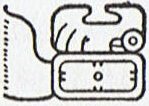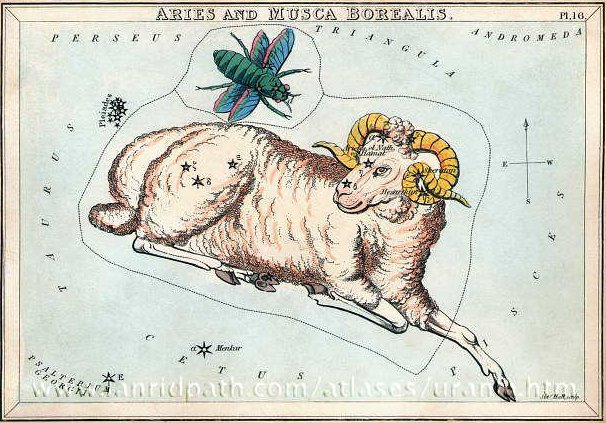The Hindu Bharani nakshatra is the 2nd among 28 lunar stations, and the 1st station is associated with a head. Possibly the Hindu 'point' could have been regarded as belonging in the preceding 'new moon' phase of time when there is no light.
Bharani is also the name of the star 41 Arietis. Furthermore, I have named 35 Arietis the Head of the Fly and 39 Arietis the Right Wing of the Fly. The 4th star in this quartet is γ Ceti (Kaffaljidhma) and by a kind of logic this star could personify the recipient of the manu rere (descending fly) - i.e. if Cetus corresponds to the giant 'clam-shell' which has stranded (noho). Kaffaljidhma is the head of Cetus: ... Al Kaff al Jidmah is the Arabs' name for the whole group marking the Whale's head, but in modern lists is exclusively applied to this star. There is much more to it, though: ... In spring the 'head' in the sky evidently is in the focus of interest - its presence is necessary for the growth in the fields. But 'kaff' in Kaffaljidhma does not mean literally 'head': 'The Arabian astronomers of course knew the Greek constellations and called it [Cetus] Al Ketus, from which have come Elketos, Elkaitos, and Elkaitus; but their predecessors, who had not heard of the Royal Family and its foe, separated these stars into three very different asterisms. Those in the head, α, γ, δ, λ, μ, ξ¹and ξ² , were Al Kaff al Jidmah, the Part of a Hand, from a fancied resemblance to their Stained Hand, our Cassiopeia ...' (Allen) ... the early Arabs had a very different figure here, in no way connected with the Lady as generally is supposed, - their Kaff al Hadib, the large Hand [cfr Caph] Stained with Henna, the bright stars marking the fingertips; although in this they included the nebulous group in the left hand of Perseus. Chrysococca gave it thus in the Low Greek Χείρ βεβαμένη; and it sometimes was the Hand of, i.e. next to, the Pleiades ... Evidently at least three different meanings adhere to kaff: 1) head, 2) hand, and 3) next to ... Tagata in Ca2-14 has his left hand held high as a sign of kai. It could be a reference to the large Hand Stained with Henna. A hand which perhaps returns in the east - next to the rising Pleiades - what had beeb collected half a year earlier at the horizon in the west.
It seems quite possible the returning Bharani fly spirit should visit several flower 'heads' on Land, first of all the head of the Ewe (Ram, Horse) defined by β and γ Arietis (Sheratan respectively Mesarthim) which were rising heliacally 'next to' Polaris (in April 17 in rongorongo times):
The returning life spirits must reach all parts of land. At Ca2-11 Metoro said tagata oho ki roto o to vai and this sounds like the final for the person (tagata) who is leaving (oho). The departure is not to te tai but the end is rather due to a conjunction with vai - ki roto o to vai. The migration of souls is nowadays not the result of a conjunction with the Milky Way up in the sky but it happens each year down here on earth. The head of Cetus ought to be represented by Menkar, not far from 3h:
Honui in Ca2-19 is 'eating' (kai) and his (her?) 'eyes' are evidently not properly rounded as they should be, not well fed or pregnant. It is manzil day 354 (= 12 * 29½), and May 5 can be written 5-5 and day 125 can be counted as 5 * 5 * 5. The G text is not beginning with May 5 but with May 25, which can be expressed as 5-25 or 5 * 25 = 125. The manzil Alrescha is named after the star Alrisha (α Piscium), the knot anchored to the neck of Cetus according to Hevelius. There are erua tagata where Alrisha rose heliacally and there are erua tamaiti where the manzil Alrescha is beginning.
Metoro's kua hua te rima (at Ca2-13) could mean 'the offspring of 5' = the proliferation caused by 'fire' (light / life), the result of the return of the feathery spirits of breath. The position of the children (tamaiti) in the text probably alludes to day 216 (August 4), and 216 = 2 / 5 * 540 = 360 * 3 / 5. | |||||||||||||||||||||||||||||||||||||||||||||||||||||||||||||||||||||||||||||||||||||||||||||||||||||||||||||||||||











